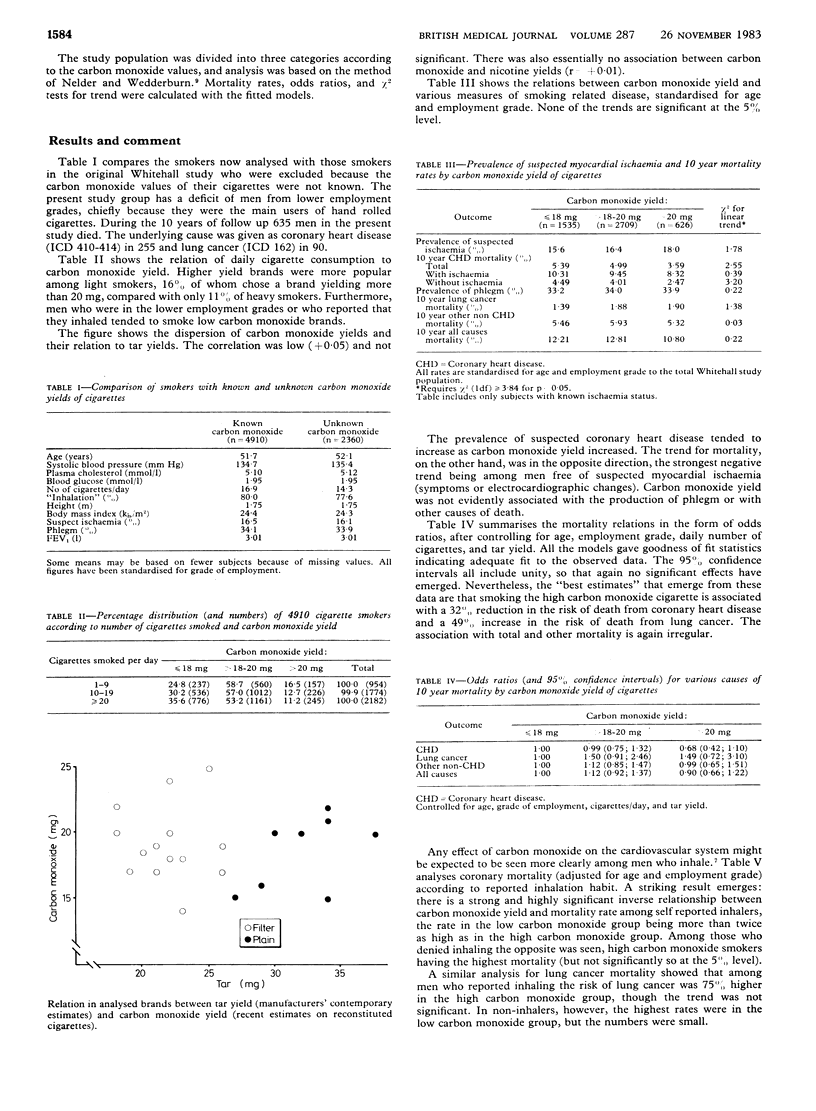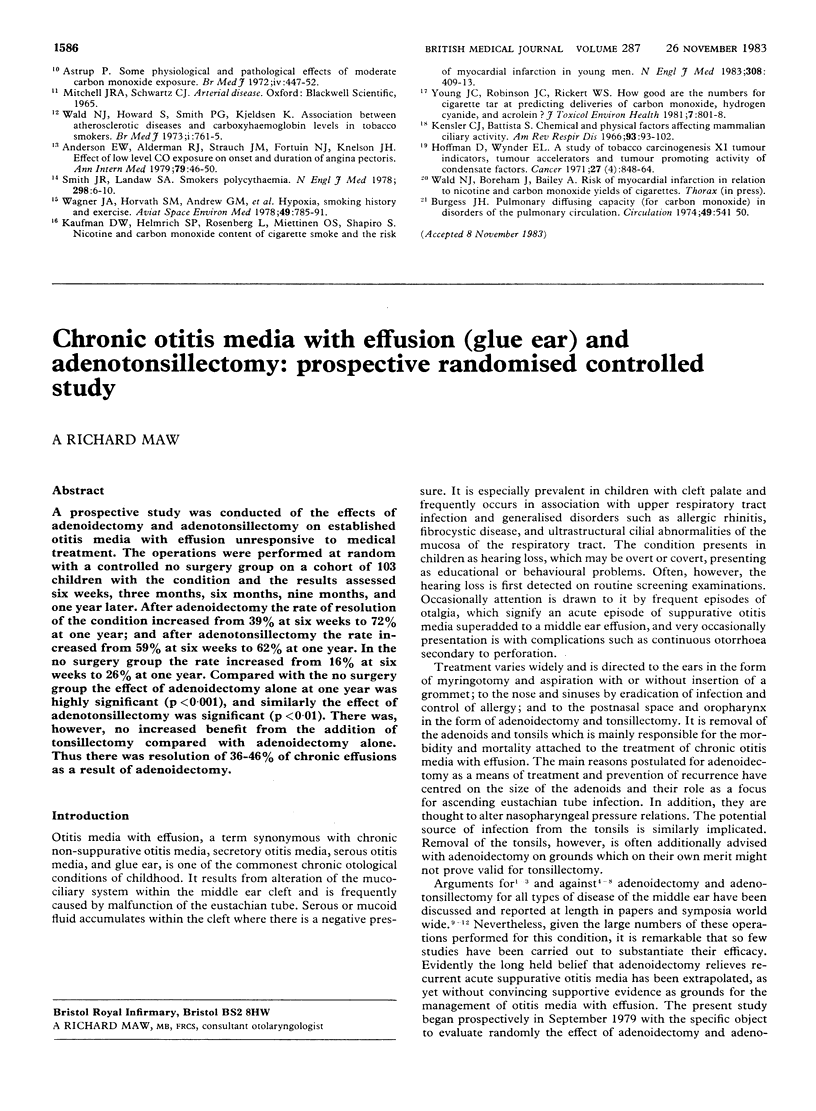Abstract
Estimates of the carbon monoxide yield of their cigarettes have been obtained for 4910 smokers (68% of all smokers) in the Whitehall study of men aged 40 to 64. In the 10 years after examination 635 men died. When men smoking cigarettes with high carbon monoxide yield were compared with those smoking cigarettes with a low yield, and after adjusting for age, employment grade, amount smoked, and tar yield, the risk of death was 32% lower for coronary heart disease, 49% higher for lung cancer, and 10% lower for total mortality; these differences were not statistically significant. Among men who said that they inhaled the risk of fatal coronary heart disease was 51% lower in the high carbon monoxide group (p less than 0.01), while the risk of lung cancer was 75% higher. These results provide no evidence that a smoker can reduce his risk of death by smoking a brand with a low carbon monoxide yield; he might even increase it. The complex interactions between characteristics of the smoker, smoking behaviour, constituents of tobacco smoke, and health are again demonstrated.
Full text
PDF



Selected References
These references are in PubMed. This may not be the complete list of references from this article.
- Anderson E. W., Andelman R. J., Strauch J. M., Fortuin N. J., Knelson J. H. Effect of low-level carbon monoxide exposure on onset and duration of angina pectoris. A study in ten patients with ischemic heart disease. Ann Intern Med. 1973 Jul;79(1):46–50. doi: 10.7326/0003-4819-79-1-46. [DOI] [PubMed] [Google Scholar]
- Astrup P. Some physiological and pathological effects of moderate carbon monoxide exposure. Br Med J. 1972 Nov 25;4(5838):447–452. doi: 10.1136/bmj.4.5838.447. [DOI] [PMC free article] [PubMed] [Google Scholar]
- Burgess J. H. Pulmonary diffusing capacity in disorders of the pulmonary circulation. Circulation. 1974 Mar;49(3):541–550. doi: 10.1161/01.cir.49.3.541. [DOI] [PubMed] [Google Scholar]
- Calverley P. M., Leggett R. J., Flenley D. C. Carbon monoxide and exercise tolerance in chronic bronchitis and emphysema. Br Med J (Clin Res Ed) 1981 Oct 3;283(6296):878–880. doi: 10.1136/bmj.283.6296.878. [DOI] [PMC free article] [PubMed] [Google Scholar]
- Fein A., Grossman R. F., Jones J. G., Hoeffel J., McKay D. Carbon monoxide effect on alveolar epithelial permeability. Chest. 1980 Nov;78(5):726–731. doi: 10.1378/chest.78.5.726. [DOI] [PubMed] [Google Scholar]
- Higenbottam T., Shipley M. J., Rose G. Cigarettes, lung cancer, and coronary heart disease: the effects of inhalation and tar yield. J Epidemiol Community Health. 1982 Jun;36(2):113–117. doi: 10.1136/jech.36.2.113. [DOI] [PMC free article] [PubMed] [Google Scholar]
- Hoffmann D., Wynder E. L. A study of tobacco carcinogenesis. XI. Tumor initiators, tumor accelerators, and tumor promoting activity of condensate fractions. Cancer. 1971 Apr;27(4):848–864. doi: 10.1002/1097-0142(197104)27:4<848::aid-cncr2820270415>3.0.co;2-4. [DOI] [PubMed] [Google Scholar]
- Kaufman D. W., Helmrich S. P., Rosenberg L., Miettinen O. S., Shapiro S. Nicotine and carbon monoxide content of cigarette smoke and the risk of myocardial infarction in young men. N Engl J Med. 1983 Feb 24;308(8):409–413. doi: 10.1056/NEJM198302243080801. [DOI] [PubMed] [Google Scholar]
- Kensler C. J., Battista S. P. Chemical and physical factors affecting mammalian ciliary activity. Am Rev Respir Dis. 1966 Mar;93(3 Suppl):93–102. doi: 10.1164/arrd.1966.93.3P2.93. [DOI] [PubMed] [Google Scholar]
- Reid D. D., Brett G. Z., Hamilton P. J., Jarrett R. J., Keen H., Rose G. Cardiorespiratory disease and diabetes among middle-aged male Civil Servants. A study of screening and intervention. Lancet. 1974 Mar 23;1(7856):469–473. doi: 10.1016/s0140-6736(74)92783-4. [DOI] [PubMed] [Google Scholar]
- Schievelbein H. Evaluation of the role of carbon monoxide and nicotine in the pathogenesis of arteriosclerosis and cardiovascular disease. Prev Med. 1979 May;8(3):379–389. doi: 10.1016/0091-7435(79)90015-x. [DOI] [PubMed] [Google Scholar]
- Smith J. R., Landaw S. A. Smokers' polycythemia. N Engl J Med. 1978 Jan 5;298(1):6–10. doi: 10.1056/NEJM197801052980102. [DOI] [PubMed] [Google Scholar]
- Sone S., Higashihara T., Kotake T., Morimoto S., Miura T. Pulmonary manifestations in acute carbon monoxide poisoning. Am J Roentgenol Radium Ther Nucl Med. 1974 Apr;120(4):865–871. doi: 10.2214/ajr.120.4.865. [DOI] [PubMed] [Google Scholar]
- Wagner J. A., Horvath S. M., Andrew G. M., Cottle W. H., Bedi J. F. Hypoxia, smoking history, and exercise. Aviat Space Environ Med. 1978 Jun;49(6):785–791. [PubMed] [Google Scholar]
- Wald N., Doll R., Copeland G. Trends in tar, nicotine, and carbon monoxide yields of UK cigarettes manufactured since 1934. Br Med J (Clin Res Ed) 1981 Mar 7;282(6266):763–765. doi: 10.1136/bmj.282.6266.763. [DOI] [PMC free article] [PubMed] [Google Scholar]
- Wald N., Howard S., Smith P. G., Kjeldsen K. Association between atherosclerotic diseases and carboxyhaemoglobin levels in tobacco smokers. Br Med J. 1973 Mar 31;1(5856):761–765. doi: 10.1136/bmj.1.5856.761. [DOI] [PMC free article] [PubMed] [Google Scholar]
- Young J. C., Robinson J. C., Rickert W. S. How good are the numbers for cigarette tar at predicting deliveries of carbon monoxide, hydrogen cyanide, and acrolein? J Toxicol Environ Health. 1981 May;7(5):801–808. doi: 10.1080/15287398109530021. [DOI] [PubMed] [Google Scholar]


